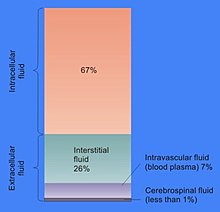Extracellular fluid
This article includes a list of references, related reading, or external links, but its sources remain unclear because it lacks inline citations. (May 2015) |

Extracellular fluid (ECF) or extracellular fluid volume (ECFV) usually denotes all body fluid outside the cells. The remainder is called intracellular fluid (ICF). The ECF and ICF are the two major fluid compartments, which together account for total body water (TBW).
In some animals, including mammals, the ECF can be divided into two major subcompartments, interstitial fluid and blood plasma, which make up at least 97%. The extracellular fluid also includes the transcellular fluid, which comprises about 2.5%. It also includes the acellular portion of lymph by the obligate logic of the outside-the-cells definition, although discussions of ECF usually treat lymph as negligible or implicitly lump it together with the interstitial fluid. One way of viewing the ECF is that it has "two components: plasma and lymph as a delivery system, and interstitial fluid for solute exchange."[1]
In humans, the normal glucose concentration of extracellular fluid that is regulated by homeostasis is approximately 5 mM, and the pH is tightly regulated by buffers around 7.4. The volume of ECF is typically 15 L, of which 12 L is interstitial fluid and 3 L is plasma. Interstitial fluid makes up 16% of human body weight, and blood plasma, 4%.
Function
Extracellular fluid, in conjunction with intracellular fluid, helps control the movement of water and electrolytes throughout the body. In order to maintain osmotic balance, the extracellular compartments of a mammal's body must be able to excrete and absorb water to and from the environment. Inorganic ions must also be exchanged between ECF and the external environment to maintain homeostasis. These exchanges occur across specialized epithelial cells and through a filtration process in the kidneys. Extracellular fluid allows a solute balance between the outside and the inside of the cell, or to produce a gradient (which is commonly used to initiate diffusion, osmosis, facilitated diffusion, active transport, etc.). Blood flow delivers oxygen to arterioles, capillaries, and venules and clears waste products of metabolism. A second flow of fluid important to organ function is filtration of plasma across the microcirculation into the interstitial lymphatic compartment of the ECF. Multiple mechanisms regulate this flow and the distribution of ECF between the plasma volume and interstitial lymphatic fluid compartments.
Constituents
- Main cations:
Sodium (Na+ = 136–145 mEq/L) Potassium (K+ = 3.5–5.5 mEq/L) Calcium (Ca2+ = 2.2–2.6 mEq/L)
- Main anions:
Chloride (Cl− = 99–109 mEq/L) Hydrogen Carbonate (HCO3− 22–26 mM)
It is poorer in proteins, as compared to intracellular fluid.
- Ionic Composition
Na+ 150 (mM)
K+ 5 (mM)
Cl− 110 (mM)
Description
Extracellular fluid is the body fluid that is not contained in cells. It is often secreted by cells to provide a constant environment for cellular operation.
Location
Human ECF is found in blood, lymph, body cavities lined with serous (moisture-exuding) membranes, cavities and channels of the brain and spinal cord, and in muscle and other body tissues.
Subcompartments
- Interstitial fluid – the extracellular fluid bathing most tissues, excluding the fluid within the lymph and blood vessels.
- Blood plasma – the yellow or gray-yellow, protein-containing fluid portion of blood in which the blood cells and platelets are normally suspended.
Homeostasis
See also
References
- ^ Canavan, A; Arant, BS Jr (2009), "Diagnosis and management of dehydration in children" (PDF), Am Fam Physician, 80 (7): 692–696, PMID 19817339.
